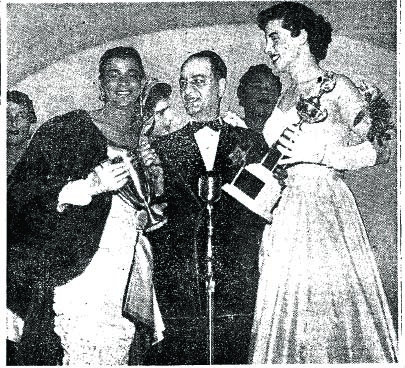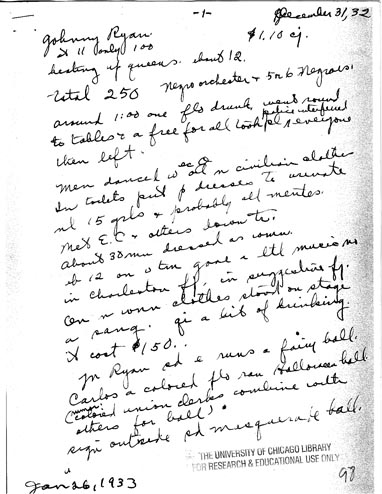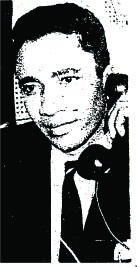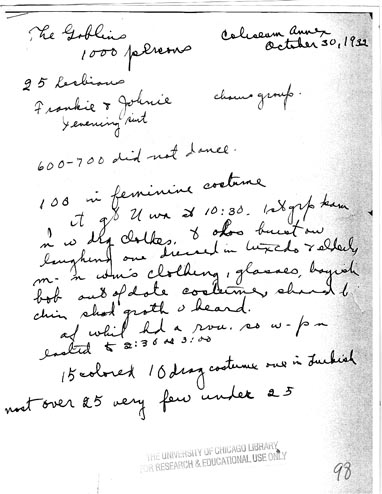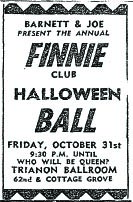The Drag Balls
Text by Tristan Cabello. Copyright (©) by Tristan Cabello, 2008. All rights reserved.
The Popularity of Drag Balls
From the early 1920s to the late 1950s, the most visible queer individuals - female impersonators, effeminate men, and masculine lesbians - were also the neighborhood’s most popular artists and entertainers. Female impersonators, for example, enjoyed a great popularity due to the “Drag Balls” organized every Halloween and New Year’s Eve. [1]
Diversity and Drag Balls
The official “approval” was made possible by the fact that the events regularly took place on Halloween and New Year’s Eve, and thus for official purposes were able to pass as conventional masquerade balls. The first Chicago balls were also racially integrated, a fact frequently remarked upon by those who attended or wrote about them. Sociology student Myles Vollmer observed:
- Physically, all types are there. Homosexuals thin and wasted, others slender and with womanish curves, others overfed and lustfully fat. Most of the younger homosexuals have pallid complexions with rather thin hair, due, perhaps, to overindulgence. There is a preponderance of Jews and the Latin Nationalities, although homosexuality is no respecter of races. Many of the men are of Polish blood. Negros mingle freely with whites. There seemingly is not race distinction between them.[2]
All types may have attended the balls, but the great majority who went did so in full drag.
- The picture is repeated over and over – colorful evening gowns, satin slippers, French heels, silken hose, gracefully displayed, tiaras, feathered fans, flashing jewelry, - all gliding about the Hall. Gliding is the only name for it, no woman could be more graceful. Trains are carefully help up by curled and manicured fingers… The “girls” (men homosexuals in female costume) move about swaying their shoulders, rolling their hips, and the only clue to their masculinity is their heavier skeletal frames, or occasionally a more masculine featured face.
One document describing a “Drag Ball” held by the “Goblins” at the Coliseum Annex on October 30, 1932, confirms that the crowd in attendance was quite diverse. Among the nearly 1,000 attendees, between 600 or 700 were mere spectators. Of the 100 attendees in costume, 25 were identified as lesbians. Of the 15 “colored” people, 10 were in costume. Female impersonators often held long careers in cabarets where they earned a good living.
“Drag Balls,” extremely popular on the South Side, were held in the neighborhood every Halloween and New Year’s Eve.
During the 1930’s, African-American business owners sponsored the balls, due to their great popularity. In Bronzeville, the Drag Balls were held in several locals, especially in the area near the Ritz Pavilion and the Eight Regiment Armory. University of Chicago sociology student Myles Vollmer described a Drag Ball as an “occasion where the Chicago officials would allow the public appearance of the intermediate sex.” The balls could also pass for conventional costume parties. According to their participants, these events were attended by Blacks and Whites, homosexuals and heterosexuals, and female impersonators. Though they were not specifically gay events, homosexuals were numerous in the audience, as well as on stage. These balls were also attended by “lesbian girls with their lovers,” dressed in “sack suits well tailored, with ties and shirts well matched.” Since 1932, a crowd of nearly one thousand people, half of them spectators, gathered on the curbs of Bronzeville’s streets, where they awaited the drag queens’ arrival, every year.
The Finnie's Balls
The most famous of these Drag Balls were the first Finnie’s balls, the first of which occurred in 1935 and was organized by a Black gay street hustler and gambler named Alfred Finnie, in the basement of a tavern on the corner of 38th street and Michigan Avenue. Guests of the ball paid twenty-five cents to attend. Nancy Kelly, who went to his first Finnie’s Ball in 1935, recalled that the event in its first years was relatively small. Until 1943, the ball was held up to five times annually at a number of different venues. As a famous female impersonator Nancy Kelly remembered, “they’d just pick out a random little shack you know. Decorate it, put up some balloons… and stuff like that. It was more homey than it is now.”
- There’d be music. There’d be food… they would have a big band, maybe a seven or eight piece band you know. Everybody’d be dancing with one another, they’d be drinking, they had table like a cabaret, and you’d dance with a drained, you’d dace with somebody else’s friends. And the lesbians would be there. Not too many of them. They would dance with the queens. The first lesbians I ever danced with I thought was a man. Her name is Billy. I thought sure Billy was a man, you know until she told me, No Baby it’ ain’t like that.”[4]
References
- ↑ See Bibliography
- ↑ ; Myles Vollmer, “The New Year’s Eve Drag,” Box 98, Folder 11, Burgess Papers, Special Collections Research Center, The Regenstein Library, The University of Chicago, Chicago, IL
- ↑ ; Myles Vollmer, “The New Year’s Eve Drag,” Box 98, Folder 11, Burgess Papers, Special Collections Research Center, The Regenstein Library, The University of Chicago, Chicago, IL
- ↑ Allen Drexel, “Before Pars Burned: Race, Class and Male Homosexuality on the Chicago South Side, 1935-1965,” in Brett Beemyn, ed., op. cit., 141;
